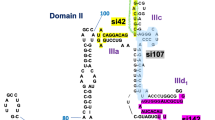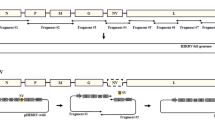Abstract
To produce artificial microRNA (amiR)-mediated self-inhibitory viral hemorrhagic septicemia virus (VHSV), we inserted VHSV P gene-targeting amiR sequence (amiR-P) or control amiR sequence (amiR-C) between N and P genes of VHSV genome, and rescued recombinant VHSVs (rVHSV-A-amiR-P and rVHSV-A-amiR-C) using reverse genetic technology. The growth of rVHSV-A-amiR-P was significantly retarded compared to the control virus, rVHSV-A-amiR-C, due to the production of self P gene transcript-attacking microRNAs in infected cells. To enhance the replication of rVHSV-A-amiR-P, we generated the Dicer gene-knockout epithelioma papulosum cyprini (EPC-ΔDicer) cells using a CRISPR/Cas9 system, and evaluated the effect of Dicer knockout on the titer of rVHSV-A-amiR-P. The replication of rVHSV-A-amiR-C in EPC-ΔDicer cells was not different from that in control EPC cells, while the copy number of rVHSV-A-amiR-P was increasingly risen up in EPC-ΔDicer cells compared to that in control EPC cells, and the final viral titer of rVHSV-A-amiR-P was enhanced by culture in EPC-ΔDicer cells. These results indicate that VHSV can be attenuated by the equipment of self-mRNA-targeting microRNA sequence in the genome, and the titer of artificial miRNA-expressing attenuated recombinant VHSVs can be enhanced by the knockout of Dicer gene in EPC cells.







Similar content being viewed by others
References
Ammayappan A, Vakharia VN (2009) Molecular characterization of the Great Lakes viral hemorrhagic septicemia virus (VHSV) isolate from USA. Virol J 6:171–216
Arkush KD, Mendonca HL, McBride AM, Yun S, McDowell TS, Hedrick RP (2006) Effects of temperature on infectivity and of commercial freezing on survival of the North American strain of viral hemorrhagic septicemia virus (VHSV). Dis Aquat Org 69:145–151
Bae S, Park J, Kim JS (2014) Cas-OFFinder: a fast and versatile algorithm that searches for potential off-target sites of Cas9 RNA-guided endonucleases. Bioinformatics 30:1473–1475
Basurco B, Benmansour A (1995) Distant strains of the fish rhabdovirus VHSV maintain a sixth functional cistron which codes for a nonstructural protein of unknown function. Virol 212:741–745
Bohle H, Lorenzen N, Schyth BD (2011) Species specific inhibition of viral replication using dicer substrate siRNAs (DsiRNAs) targeting the viral nucleoprotein of the fish pathogenic rhabdovirus viral hemorrhagic septicemia virus (VHSV). Antiviral Res 90:187–194
Brown BD, Gentner B, Cantore A, Colleoni S, Amendola M, Zingale A, Baccarini A, Lazzari G, Galli C, Naldini L (2007) Endogenous microRNA can be broadly exploited to regulate transgene expression according to tissue, lineage and differentiation state. Nat Biotechnol 25:1457–1467
Burger K, Schlackow M, Potts M, Hester S, Mohammed S, Gullerova M (2017) Nuclear phosphorylated Dicer processes double-stranded RNA in response to DNA damage. J Cell Biol 216:2373–2389
Chiu Y-L, Rana TM (2003) siRNA function in RNAi: a chemical modification analysis. RNA 9:1034–1048
Cifuentes D, Xue H, Taylor DW, Patnode H, Mishima Y, Cheloufi S, Ma E, Mane S, Hannon GJ, Lawson ND, Wolfe SA, Giraldez AJ (2010) A novel miRNA processing pathway independent of Dicer requires Argonaute2 catalytic activity. Sci 328:1694–1698
Clarke BD, McColl KA, Ward AC, Doran TJ (2017) shRNAs targeting either the glycoprotein or polymerase genes inhibit Viral haemorrhagic septicaemia virus replication in zebrafish ZF4 cells. Antiviral Res 141:124–132
Davis-Dusenbery BN, Hata A (2010) Mechanisms of control of microRNA biogenesis. J Biochem 148:381–392
Fay EJ, Langlois RA (2018) MicroRNA-attenuated virus vaccines. Noncoding. RNA 4:25
Finn RD, Clements J, Eddy SR (2011) HMMER web server: interactive sequence similarity searching. Nucleic Acids Res 39:W29-37
Fragkos M, Barra V, Egger T, Bordignon B, Lemacon D, Naim V, Coquelle A (2019) Dicer prevents genome instability in response to replication stress. Oncotarget 10:4407–4423
Gregory RI, Chendrimada TP, Cooch N, Shiekhattar R (2005) Human RISC couples microRNA biogenesis and posttranscriptional gene silencing. Cell 123:631–640
Hawley LM, Garver KA (2008) Stability of viral hemorrhagic septicemia virus (VHSV) in freshwater and seawater at various temperatures. Dis Aquat Org 82:171–178
He L, Hannon GJ (2004) MicroRNAs: small RNAs with a big role in gene regulation. Nat Rev Genet 5:522–531
Leong JC (2008) Fish viruses. In: Encyclopedia of virology. Elsevier: 227–234
Jopling CL, Yi M, Lancaster AM, Lemon SM, Sarnow P (2005) Modulation of hepatitis C virus RNA abundance by a liver-specific microRNA. Sci 309:1577–1581
Kelly EJ, Hadac EM, Greiner S, Russell SJ (2008) Engineering microRNA responsiveness to decrease virus pathogenicity. Nat Med 14:1278–1283
Kelly EJ, Nace R, Barber GN, Russell SJ (2010) Attenuation of vesicular stomatitis virus encephalitis through microRNA targeting. J Virol 84:1550–1562
Kim MS, Kim KH (2012) Effects of NV gene knock-out recombinant viral hemorrhagic septicemia virus (VHSV) on Mx gene expression in Epithelioma papulosum cyprini (EPC) cells and olive flounder (Paralichthys olivaceus). Fish Shellfish Immunol 32:459–463
Kim MS, Kim KH (2011) Inhibition of viral hemorrhagic septicemia virus replication using a short hairpin RNA targeting the G gene. Adv Virol 156:457–464
Kim MS, Kim MS, Choi SH, Choi SH, Kim KH, Kim KH (2016a) Effect of G gene-deleted recombinant viral hemorrhagic septicemia virus (rVHSV-ΔG) on the replication of wild type VHSV in a fish cell line and in olive flounder (Paralichthys olivaceus). Fish Shellfish Immunol 54:598–601
Kim MS, Shin MJ, Kim KH (2018) Increase of viral hemorrhagic septicemia virus growth by knockout of IRF9 gene in Epithelioma papulosum cyprini cells. Fish Shellfish Immunol 83:443–448
Kim S-H, Yusuff S, Vakharia VN, Evensen Ø (2015) Interchange of L polymerase protein between two strains of viral hemorrhagic septicemia virus (VHSV) genotype IV alters temperature sensitivities in vitro. Virus Res 195:203–206
Kim Y-K, Kim B, Kim VN (2016b) Re-evaluation of the roles of DROSHA, Exportin 5, and DICER in microRNA biogenesis. Proc Natl Acad Sci USA 113:E1881–E1889
Kim Y-S, Ke F, Lei X-Y, Zhu R, Zhang Q-Y (2010) Viral envelope protein 53R gene highly specific silencing and iridovirus resistance in fish Cells by AmiRNA. PLoS One 5:e10308
Kwak JS, Kim KH (2020) Enhancing immunogenicity of a reporter protein by fusion to glycoprotein and nucleoprotein of viral hemorrhagic septicemia virus (VHSV) particles. Fish Shellfish Immunol 105:35–40
Kwak JS, Kim MS, Kim KH (2019) Generation of microRNA-30e-producing recombinant viral hemorrhagic septicemia virus (VHSV) and its effect on in vitro immune responses. Fish Shellfish Immunol 94:381–388
Leyrat C, Ribeiro EA, Gérard FC, Ivanov I, Ruigrok RW, Jamin M (2011) Structure, interactions with host cell and functions of rhabdovirus phosphoprotein. Futur Virol 6:465–481
Li J, Arévalo MT, Diaz-Arévalo D, Chen Y, Choi J-G, Zeng M (2015) Generation of a safe and effective live viral vaccine by virus self-attenuation using species-specific artificial microRNA. J Control Release 207:70–76
Li P, Tian Q, Hu M, Li W, Zhang X, Zeng Y (2019) Cloning, expression, and characterization of the zebrafish Dicer and Drosha enzymes. Biochem Biophys Res Commun 514:200–204
McBride JL, Boudreau RL, Harper SQ, Staber PD, Monteys AM, Martins I, Gilmore BL, Burstein H, Peluso RW, Polisky B, Carter BJ, Davidson BL (2008) Artificial miRNAs mitigate shRNA-mediated toxicity in the brain: implications for the therapeutic development of RNAi. Proc Natl Acad Sci USA 105:5868–5873
Nilsen TW (2007) Mechanisms of microRNA-mediated gene regulation in animal cells. Trends Genet 23:243–249
Paddison PJ, Caudy AA, Bernstein E, Hannon GJ, Conklin DS (2002) Short hairpin RNAs (shRNAs) induce sequence-specific silencing in mammalian cells. Genes Dev 16:948–958
Park J, Bae S, Kim JS (2015) Cas-Designer: a web-based tool for choice of CRISPR-Cas9 target sites. Bioinformatics 31:4014–4016
Qiao C, Yuan Z, Li J, He B, Zheng H, Mayer C, Xiao X (2011) Liver-specific microRNA-122 target sequences incorporated in AAV vectors efficiently inhibits transgene expression in the liver. Gene Ther 18:403–410
Rao DD, Vorhies JS, Senzer N, Nemunaitis J (2009) siRNA vs. shRNA: similarities and differences. Adv Drug Deliv Rev 61:746–759
Ruiz S, Schyth BD, Encinas P, Tafalla C, Estepa A, Lorenzen N, Coll JM (2009) New tools to study RNA interference to fish viruses: fish cell lines permanently expressing siRNAs targeting the viral polymerase of viral hemorrhagic septicemia virus. Antiviral Res 82:148–156
Sano M, Nakasu A, Ohtaka M, Nakanishi M (2019) A Sendai virus-based cytoplasmic RNA vector as a novel platform for long-term expression of microRNAs. Mol Ther Methods Clin Dev 15:371–382
Schiøtz BL, Rosado EG, Baekkevold ES, Lukacs M, Mjaaland S, Sindre H, Grimholt U, Gjøen T (2011) Enhanced transfection of cell lines from Atlantic salmon through nucoleofection and antibiotic selection. BMC Res Notes 4:136–137
Schütze H, Mundt E, Mettenleiter TC (1999) Complete genomic sequence of viral hemorrhagic septicemia virus, a fish rhabdovirus. Virus Genes 19:59–65
Shapiro JS, Varble A, Pham AM, tenOever BR (2010) Noncanonical cytoplasmic processing of viral microRNAs. RNA 16:2068–2074
Siomi H, Siomi MC (2010) Posttranscriptional regulation of microRNA biogenesis in animals. Mol Cell 38:323–332
Tordo N, Benmansour A, Calisher C, Dietzgen RG, Fang RX, Jackson AO, Kurath G, Nadin-Davis SA, Tesh RB, Walker PJ (2005) Family Rhabdoviridae. Netherlands, Elsevier, Amsterdam
Waring BM, Sjaastad LE, Fiege JK, Fay EJ, Reyes I, Moriarity B, Langlois RA (2018) MicroRNA-based attenuation of influenza virus across susceptible hosts. J Virol 92:3
Winter J, Jung S, Keller S, Gregory RI, Diederichs S (2009) Many roads to maturity: microRNA biogenesis pathways and their regulation. Nat Cell Biol 11:228–234
Wu C, Lin J, Hong M, Choudhury Y, Balani P, Leung D, Dang LH, Zhao Y, Zeng J, Wang S (2009) Combinatorial control of suicide gene expression by tissue-specific promoter and microRNA regulation for cancer therapy. Mol Ther 17:2058–2066
Ylösmäki E, Martikainen M, Hinkkanen A, Saksela K (2013) Attenuation of Semliki Forest virus neurovirulence by microRNA-mediated detargeting. J Virol 87:335–344
Zempleni J, Baier SR, Howard KM, Cui J (2015) Gene regulation by dietary microRNAs. Can J Physiol Pharmacol 93:1097–1102
Acknowledgements
This research was a part of the project titled “Development of Fish Vaccines and Human Resource Training,” funded by the Ministry of Oceans and Fisheries, Korea.
Funding
This work was funded by the Ministry of Oceans and Fisheries, Korea. The project title is “Development of Fish Vaccines and Human Resource Training.”
Author information
Authors and Affiliations
Contributions
JSK carried out the experiment and wrote the original draft preparation. KHK supervised the study and did the writing-reviewing and editing.
Corresponding author
Ethics declarations
Conflict of Interest
The authors declare no competing interests.
Additional information
Publisher's Note
Springer Nature remains neutral with regard to jurisdictional claims in published maps and institutional affiliations.
Key Points
• Self-inhibitory VHSV was rescued by inserting P gene targeting-microRNA into the genome.
• Dicer gene knockout EPC cells were established using CRISPR/Cas9.
• Replication of self-inhibitory VHSV was enhanced in EPC-ΔDicer cells.
Rights and permissions
About this article
Cite this article
Kwak, J.S., Kim, K.H. Generation of Self-Inhibitory Recombinant Viral Hemorrhagic Septicemia Virus (VHSV) by Insertion of Viral P Gene-Targeting Artificial MicroRNA into Viral Genome and Effect of Dicer Gene Knockout on the Recombinant VHSV Replication. Mar Biotechnol 23, 546–559 (2021). https://doi.org/10.1007/s10126-021-10045-4
Received:
Accepted:
Published:
Issue Date:
DOI: https://doi.org/10.1007/s10126-021-10045-4




